Nightmare 4K Blu-ray Movie
HomeNightmare 4K Blu-ray Movie 
Nightmares in a Damaged Brain / 4K Ultra HD + Blu-raySeverin Films | 1981 | 97 min | Not rated | Jan 30, 2024
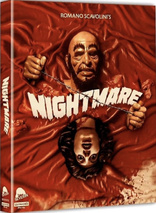
Movie rating
6.4 | / 10 |
Blu-ray rating
| Users | 0.0 | |
| Reviewer | 4.5 | |
| Overall | 4.5 |
Overview
Nightmare 4K (1981)
Mentally unbalanced patient, George Tatum, is released from a New York mental hospital, slums it up on sleazy 42nd Street, and then travels to Florida to terrorize an unsuspecting family. Brutal, uncompromising, and graphic, this is one NIGHTMARE that you'll never forget! Originally released unrated to theaters during the height of the slasher craze in the early 1980s, this slasher-splatter classic has garnered a huge cult horror fanbase in the years since.
Starring: Baird Stafford, Sharon Smith (I), C.J. Cooke, Mik Cribben, Danny RonanDirector: Romano Scavolini
| Horror | 100% |
Specifications
Video
Video codec: HEVC / H.265
Video resolution: 4K (2160p)
Aspect ratio: 1.85:1
Original aspect ratio: 1.85:1
Audio
English: DTS-HD Master Audio 5.1 (48kHz, 24-bit)
English: DTS-HD Master Audio 2.0 (48kHz, 24-bit)
Subtitles
English SDH
Discs
Blu-ray Disc
Three-disc set (3 BDs)
4K Ultra HD
Packaging
Slipcover in original pressing
Playback
Region A (B, C untested)
Review
Rating summary
| Movie | 3.5 | |
| Video | 4.0 | |
| Audio | 3.5 | |
| Extras | 5.0 | |
| Overall | 4.5 |
Nightmare 4K Blu-ray Movie Review
Reviewed by Dr. Stephen Larson September 23, 2023Severin Films has released Romano Scavolini's NIGHTMARE (1981) in a three-disc set. The limited edition includes two archival audio commentaries, a long interview with Scavolini, both vintage and new cast/crew interviews, a locations tour, a feature-length documentary on the film's British distributor, excised scenes, galleries, and trailers. The UHD and two BD-50s are region-free.
The production of Nightmare is a case where director Romano Scavolini's unorthodox storytelling approach clashed with a more conventional approach favored by his producers. Scavolini brought a European sensibility to this film predicated on ambiguity and open-ended plot lines. By contrast, producer John Watkins and one of the picture's executive producers advocated an explanatory model which clearly delineates the characters' motives and happenings in the story. The resulting film is a hodgepodge of the two approaches. Scavolini's original screenplay was 167 pages. He wanted the movie to run at least two hours, but as he explains in a new interview on the second disc of this set, he was compelled to trim it down to around an hour and a half so New York exhibitors could fit in more daily showings. Scavolini always wanted the film titled Nightmare, but it was changed to Dark Games during production, only to revert back to the original title when the film opened domestically in October 1981.
Nightmare was part of the early cycle of slasher films. It takes on a different angle than many of them. As Scavolini explains so well in the interview, the story is inspired by the CIA's MKULTRA program in which experimental subjects were given psychotropic drugs. George Tatum (Baird Stafford) is one of the guinea pigs in a government agency's program. He's been locked up ever since committing a most heinous act during his childhood. George's psychiatrist Paul Williamson (Bill Milling) and the program's top brass are convinced that a wonder drug is working on their patient. Quite inexplicably, George gets out. He travels from New York down to South Carolina and all the way to Florida. George has an idée fixe for attacking beautiful ladies. No one is safe around him. He sets his sights on a lower middle-class suburban home in Cocoa Beach where single mom Susan Temper (Sharon Smith) lives with her three children, including miscreant C.J. (C.J. Cooke). As the narrative unfolds, it becomes clearer why George is targeting this family.
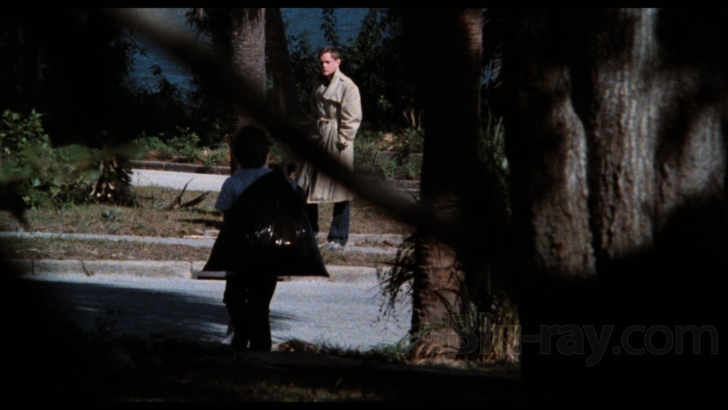
George confronts C.J.
Nightmare patterns several of its scenes after Halloween (1978). For example, there's a shifty point-of-view shot of a prowler outside the Temper's house tracking Kathy (Danny Ronan), the family babysitter. (There's a reason why Halloween was initially called The Babysitter Murders!) Later in Nightmare, there's a lovemaking scene between Kathy and her boyfriend that's literally influenced by a sex scene with Lynda (P.J. Soles) and Bob (John Michael Graham) in Carpenter's classic. Whoever cast local child actor C.J. Cooke made a clever choice because he looks like a close cousin to Brian Andrews, who plays Tommy in Halloween. They each have blond fishbowl hair and a natural curiosity about them. However, there are important differences between the two characters. Whereas Tommy is always upfront and truthful when he sees the bogeyman, C.J. is much less trustworthy. He's such a serial liar and prankster that his mother and her boyfriend don't believe him when he points to his purported stalker on the beach.
Nightmare is not a knockoff of Halloween. While the latter definitely shows its influence on Scavolini and his collaborators, Nightmare is relatively original in its own right. It has to rank as one of the horror genre's best splatter fests of the decade. The film's main weakness is that it cuts away too often in George's mind screen to the traumatic boyhood event that continually haunts him. Nightmare loses some of its subtlety in the process. The cutaways may have been dictated by John Watkins to editor Joe Zwick since Scavolini was not present in the editing room. In any case, the film doesn't need some of these smash cuts to repeated flashbacks. All in all, this is still a very solid effort for an ultra low-budget indie.
Nightmare 4K Blu-ray Movie, Video Quality 
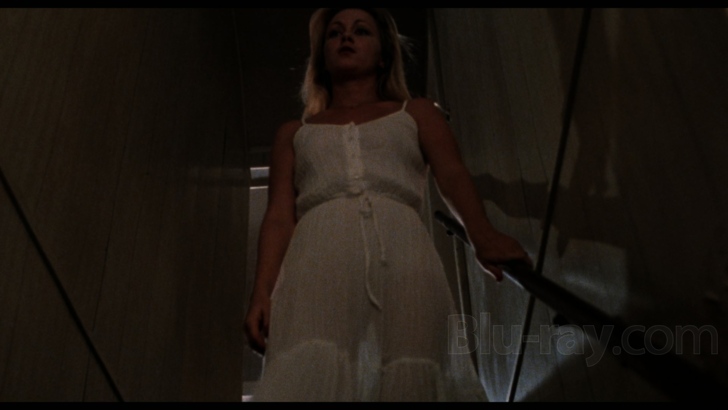
Severin Films' three-disc package includes an embossed slipcover with reversible cover artwork. We did not review Code Red's "35 Anniversary Edition" Blu-ray, which is struck from a 2103 master. The feature presentation on the UHD and the first Blu-ray disc were "scanned from the internegative and various foreign print sources to create the most complete version ever assembled." This 99-minute cut is longer than any of the release prints shown in the US that I am aware of. For its extended run in New York, Nightmare played at 97 minutes. It had an identical runtime in Virginia-area theaters. When the picture was exhibited in Los Angeles theaters in 1982, it had the shorter length of 94 minutes. The Severin transfer is a composite, consolidating missing frames extant on other prints shown in international markets.
Nightmare was shot on Arriflex 35 mm film and appears in its original theatrical aspect ratio of 1.85:1. It boasts a very rough and gritty texture typical of film stocks used for '80s indies. Grain is omnipresent. Severin has done a commendable job of cleaning up dirt and excess artifacts. Some ultra-thin vertical tramlines remain. For example, see one present on Susan's left cheek in Screenshot #3. In Screenshot #s 25-26, during another phone scene (Nightmare has lots of them), there are strange halo spots directly above Susan's hair. You'll notice them more in motion. Their presence probably has something to do with the grain pattern and the hues. But they don't mesh well. It likely was difficult for Severin to remove them unless it resorted to blatant DNR. Thankfully, noise reduction has not been used.
The HDR10 on the 4K enhances detail on faces and skin complexions in general. I feel the HDR brings out the lighting effects in the psychiatric clinic rather well. Ditto for the street lamps and neon lights illuminated on storefronts along 42nd Street. The HDR also deepens the blacks but also accents murky characteristics in the image. The HDR only occasionally stands out. A film like Nightmare transfers to 2K resolution just as well, if not better. The addition of more pixels on a dark movie like this can tend to thicken the textures, which sometimes creates a swarm effect in the grain field. It's nice to have Nightmare on 4K but I will likely return to the standard Blu-ray more often.
The BD-66 sports an average bitrate of 74.0 Mbps and an overall bitrate of 83.0 Mbps. Severin's Blu-ray for Nightmare (disc size: 33.60 GB) has a superior encode compared to Code Red's. Severin's MPEG-4 AVC encode for the feature carries a mean video bitrate of 36764 kbps, which is an upgrade over Code Red's quite meager bitrate of 19000 kbps.
Screenshot #s 1-10, 12, 14, 16, 18, 20, 22, 24, 26, 28, 30, 32, 34, 36, 38, & 40 = 4K Ultra HD (downsampled to 1080p)
Screenshot #s 11, 13, 15, 17, 19, 21, 23, 25, 27, 29, 31, 33, 35, 37, & 39 = Blu-ray (2023 Severin Films BD-50)
A dozen chapters accompany the 99-minute feature.
Nightmare 4K Blu-ray Movie, Audio Quality 
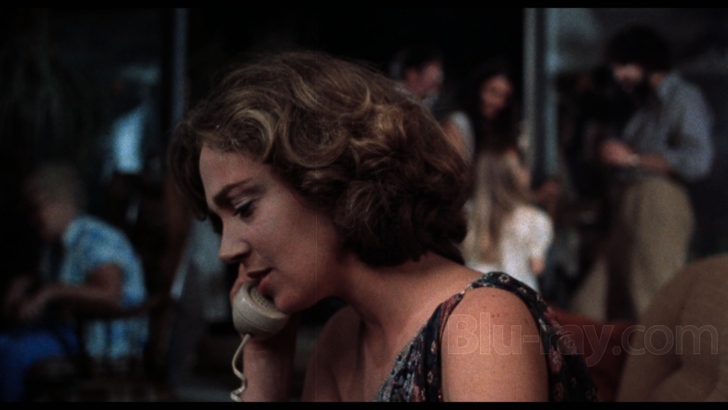
Severin has supplied a DTS-HD Master Audio 5.1 remix (3384 kbps, 24-bit) and a DTS-HD Master Audio 2.0 Stereo track (2040 kbps, 24-bit). It seems that the stereo track is merely a downmix of the 5.1. Spoken words are widened to the front left and front right channels instead of focalized to the center speaker. Disappointingly, the film's original mono has not been included on either disc. Still, the master used for this release is in reasonably good shape. On the 5.1 track, I can pick out low-end sounds well. The satellite speakers occasionally deliver on musical score, street noises, and jet sounds of a commercial airplane. Jack Eric Williams's score is long overdue for an album release. His main theme is built around bass guitar and harmonica. He also incorporates a pan flute for scenes involving C.J. and other scenes that gradually build suspense. Williams's bass guitar flanger effect for the extended scene inside a derelict Florida house was no doubt influenced by the flanger Harry Manfredini uses quite memorably in Friday the 13th (1980).
I watched Nightmare a second time with the optional English SDH on. Severin did a practically flawless job with the dialogue transcriptions.
Nightmare 4K Blu-ray Movie, Special Features and Extras 
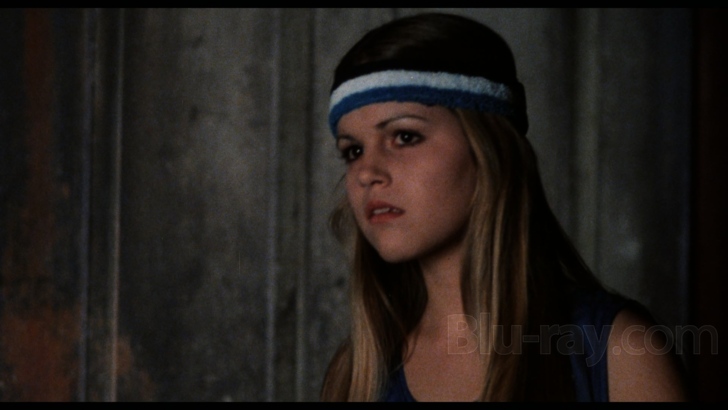
Disc 1: UHD
- Audio Commentary With Star Baird Stafford and Special Effects Assistant Cleve Hall, Moderated By Lee Christian and David DeCoteau - this feature-length track was originally recorded by Code Red for the label's 35th Anniversary Edition DVD and Blu-ray releases in 2014. The late Baird Stafford had an outstanding memory that's on full display here. He recalls many scenes shot and also what occurred on set. Stafford additionally remembers working with director Romano Scavolini, who he reunited with on the Italian's next film, Dog Tags (1987). Special f/x artist Cleve Hall delves into how he pulled off some of the kills. One of the moderators points out that because the camera negative was deemed too smelly, it was deemed unusable and probably destroyed. He said the Code Red transfer was likely sourced from a 35 mm print. In English, not subtitled.
- Audio Commentary With Producer William Paul - this feature-length track with Paul was initially recorded by UK label 88 Films for its 2015 Blu-ray. Paul is self-deprecating in a cantankerous way. He laments the studio execs, fellow producers, and actors who were obstreperous during the making of Nightmare. He often delivers his remarks sardonically and with irreverence. Paul discusses the picture's filming locations, budgetary disputes, conflicts during filming, and relationships between actors and crew members. Paul delivers several anecdotes and production stories. He sometimes describes what's happening on screen. He repeats himself when reciting some of the sayings by crew members he remembers hearing from the set, which he mocks. In English, not subtitled.
- Trailers (2:31, 1080p) - good transfers of two almost identical theatrical trailers for Nightmare. They appear in 1.78:1 anamorphic widescreen. There's some dirt, artifacts, and very thin tramlines. The differences in content are small but significant. One promotes Savini's fallacious role in the production, the other doesn't.
Disc 2: Blu-ray
- NEW Kill Thy Father and Thy Mother – Interview With Director Romano Scavolini (1:11:44, 1080p) - in lieu of having him do a commentary track, Severin recorded a lengthy interview with Scavolini instead. The Italian auteur has an incredible memory. He proceeds to tell in chronological fashion the genesis of Nightmare, meeting producer Bill Paul, and his various encounters with producer John Watkins while making the picture. Scavolini also discusses the actors who auditioned and were later chosen to play adult George, Susan, C.J., and young George. He has a completely different take than Savini, who Scavolini says failed to divulge the residuals he coveted after Nightmare became a box-office success in New York. This is a great interview and a must watch. Scavolini speaks in his native Italian, subtitled in English.
- Dreaming Up a Nightmare (39:09, 1080p; some interviews were recorded at lower resolutions and have been upconverted here) - this program is a compilation of older and more recent interviews with Nightmare's cast and crew. We hear from the former President of 21st Century Distribution, Arthur Schweitzer, as well as actor/unit production manager Mik Cribben, production supervisor Simon Nuchtern, Florida producer/special effects artist William Milling, and uncredited editor Jim Markovic. In addition, there are archival interviews with star Baird Stafford as well as special effects artists Edward French and Cleve Hall. Video quality varies depending on source. In English, not subtitled.
- NEW The Nightmare of NIGHTMARE – Interview With Erroneously Credited Special Effects Director Tom Savini (7:34, 1080p) - Savini sits down with Michael Felsher to clarify exactly what role he had on Nightmare. He makes belated news by discussing the late Lester Lorrain's contribution to the film. In English, not subtitled.
- NEW The Stuff That Nightmares Are Made of – Interview With Makeup Artist Robin Stevens (12:18, 1080p) - Stevens explains the circumstances that led to her hiring on the Nightmare film. She shares several memories of working with Cleve Hall, Ed French, Romano Scavolini, and Gianni Fiore. She also has recollections of Tom Savini. Stevens shows several of the photos that were taken during Nightmare's production. In English, not subtitled.
- NEW A Nightmare on Many Streets – A Locations Tour With Rue Morgue Writer Michael Gingold (11:05, 1080p) - Before he visits several of the locales where Nightmare was filmed, Gingold first stops by the New York theater where the movie was shown. The revisited locations include the same street scenes where George strolled in the film, the Carnegie Hall Tower where Bill Milling and John Watkins's scenes were likely shot, Staten Island, Coco Beach, a Florida marina, and Susan's house from the outside. In English, not subtitled.
- Open Matte Peep Show Sequence (2:45, 1080p) - George's appearance at the peep show is presented here in 1.33:1 with good image quality.
- Deleted Scenes (1:18, upconverted to 1080p) - two omitted scenes from Nightmare that Severin was able to recover. The first is culled from the Australian and Dutch videocassette releases. It has pops and crackles on the audio track. An additional scene contains ten extra frames that are not present on any other version except for the Dutch VHS. Both are presented in 1.33:1. The first doesn't display any subtitles. Second presents Dutch and English subs.
- Still Gallery (10:14, 1080p) - a slide show (with wipe effects) that presents 175 images showcasing the promotion and controversy surrounding Nightmare's release. The gallery has a section for publicity in the US, UK, France, Mexico, and Argentina. It also boasts an extensive home video gallery with VHS covers from the US, Canada, UK, France, Germany, Holland, Spain, Sweden, Portugal, Australia, Mexico, and Argentina. "Press" in the US contains ads and critical reviews. The UK section has lots of articles on the "Video Nasties" case. "Special Effects: Ed French" displays photos that were shot on the set of Nightmare. Lastly, there's "Make Up: Robin Stevens" with photos preserved in the said makeup artist's collection. The gallery also sports photographs from the US press kit and lobby cards from foreign markets. You'll want to have the "Pause" button handy as the slide show moves fast. I wish Severin had made the articles available on a BD-ROM.
- Trailers (2:31, 1080p) - good transfers of two almost identical theatrical trailers for Nightmare. They appear in 1.78:1 anamorphic widescreen. There's some dirt, artifacts, and very thin tramlines. The differences in content are small but significant. One promotes Savini's fallacious role in the production, the other doesn't.
Disc 3: Blu-ray
- NEW Damaged: The Very British Obscenity of David Hamilton-Grant (1:11:45, 1080p, DTS-HD Master Audio 2.0) - Sarah Appleton produced, directed, and edited this documentary on notorious UK video distributor David Hamilton-Grant. Appleton does an excellent job of providing a historical overview of British censorship and how content producers have circumvented anti-obscenity laws since George Bernard Shaw did with one of his plays in the early twentieth century. The middle of the doc discusses Hamilton-Grant's early career as a pornographer from his so-called sex-education films to his sex comedies and sexploitation flicks. The next part covers his tenure at World of Video 2000, which distributed Scavolini's 1981 film (re-titled Nightmares in a Damaged Brain). The last second examines the Video Nasties court case and Hamilton-Grant's prosecution for failing to abide by the BBFC's mandated cuts for Nightmare. Hamilton-Grant emerges as a nefarious and enigmatic figure. Appleton interviews over a dozen people. They all speak in English. The doc isn't subtitled. Severin has provided twelve chapters.
- NEW Rare David Hamilton-Grant Productions - The Office Party (53:50, 1080p, DTS-HD MA 2.0), Under the Bed (52:16, 1080p, DTS-HD MA 2.0), You're Driving Me Crazy (53:10, 1080p, DTS-HD MA 2.0), and Escape to Entebbe (8:13, 1080p, DTS-HD MA 2.0)
- Violent Nature: The Selling Of A NIGHTMARE Booklet (8 pages) - an illustrated booklet with an essay by Mondo Digital's Nathaniel Thompson, who examines the slasher movies and Italian horror pictures that were made in the same period as Nightmare. Thompson also documents Nightmare's video release history. The booklet also includes poster stills and a production photograph of a possible scene that didn't make into any cut of the film.
Nightmare 4K Blu-ray Movie, Overall Score and Recommendation 
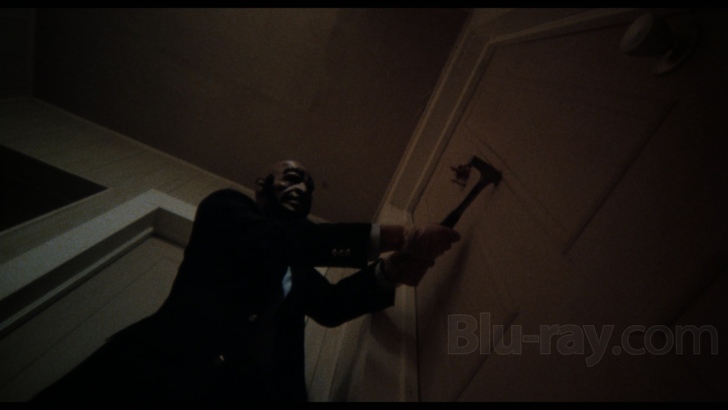
Nightmare works well as a pathological study of a violence-prone, traumatized individual and the pernicious effects hallucinatory drugs have on his psyche. The film also delivers a critical examination of George's ambivalence towards sexuality since he was a youngster and how his complete bewilderment to S&M games has a lasting impact on his temperament. I would consider Severin Films' deluxe edition definitive if only it had included the film's original mono mix, which is unfortunately not here. The transfer look aptly grainy and authentic. The extras are superabundant. Scavolini's interview is outstanding. If you picked up Vinegar Syndrome's phenomenal release of Silent Madness (1984) from a few years ago, you're sure to love this package as well. HIGHLY RECOMMENDED.
Other editions
Nightmare: Other Editions

Nightmare 4K
Nightmares in a Damaged Brain | Standard 2-Disc Edition
1981

Nightmare
Nightmares in a Damaged Brain
1981

Nightmare
Nightmares in a Damaged Brain
1981

Nightmare
Nightmares in a Damaged Brain | 4K Restoration
1981

Nightmare
1981
Similar titles
Similar titles you might also like

The Nail Gun Massacre 4K
1985

The Redeemer: Son of Satan
Limited to 1000 Copies
1978

The Burning 4K
Collector's Edition
1981

Madman
1981

Halloween
Unrated Collector's Edition
2007

The Mutilator
1985

The Boy
2015

The Boogeyman 4K
The Boogey Man
1980

Don't Go in the House
The Burning / Op de Drempel van de Gruwel / La casa del terror / Pyromaniac / Maniac 2: Non andare in casa / Nie chodz do tego domu / Das Haus der lebenden Leichen
1980

Maniac
2012

Maniac
2-Disc Special Edition
1980

The Toolbox Murders 4K
1978

Don't Go in the Woods
Standard Edition
1981

Piercing
2018

Blood Rage
1987

Censor
2021

Just Before Dawn
Deluxe Edition | SOLD OUT
1981

Scary Stories to Tell in the Dark 4K
2019

Martyrs
2015

Cabin Fever: Patient Zero
2014